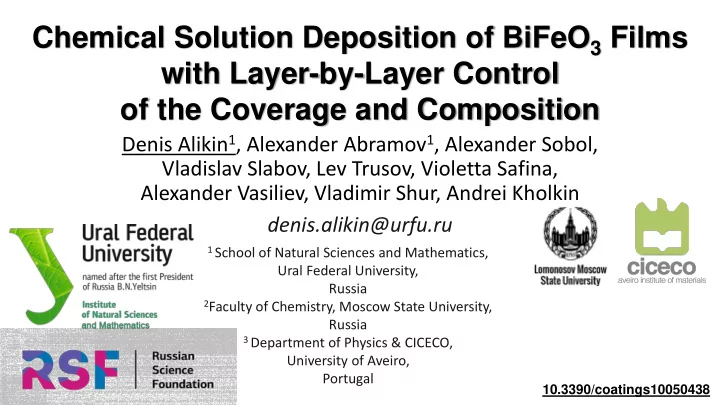

Chemical Solution Deposition of BiFeO 3 Films with Layer-by-Layer Control of the Coverage and Composition Denis Alikin 1 , Alexander Abramov 1 , Alexander Sobol, Vladislav Slabov, Lev Trusov, Violetta Safina, Alexander Vasiliev, Vladimir Shur, Andrei Kholkin denis.alikin@urfu.ru 1 School of Natural Sciences and Mathematics, Ural Federal University, Russia 2 Faculty of Chemistry, Moscow State University, Russia 3 Department of Physics & CICECO, University of Aveiro, Portugal 10.3390/coatings10050438
Motivation ❑ BiFeO 3 (BFO) is one of the most interesting multiferroic thin-film materials ✓ Model multiferroic material with uniquely high Curie (~825 ° C) and Neel transition (~360 ° C) temperatures – simultaneous ferroelectric polarization and magnetic ordering at room temperature ✓ Enormously high ferroelectric polarization in 𝑠 ~ 55 𝜈𝐷/𝑑𝑛 2 ) thin film form ( 𝑄 ❑ Chemical solution deposition (CSD) J. Wang, et al. Science 299, 1719 (2003). is of great interest because it is more suitable commercially, cheaper and makes it possible to cover large-scale wafers ❑ The use of the sol-gel route CSD allows multilayer films to be obtained by controlled layer deposition ❑ The layer-by-layer deposition is used to avoid agglomeration of the particles in the solution and 2 to achieve a thick enough film
Sample fabrication ❑ Fabrication of BiFeO 3 thin films was done using a CSD method via sol-gel route ❑ The films were prepared on Pt/TiO 2 /SiO 2 /Si(100) substrates ❑ Drying step: 1. 125 ° C, 40 min - “low -temperature- dried”, LTD 2. 300 ° C, 5 min - “high -temperature- dried”, HTD ❑ Pyrolysis and crystallization step: ✓ 300 ℃ , 60 min, and 600 ℃ , 40 min in air atmosphere ✓ Slowly cooling down at 5 o C/min rate 3
Scanning electron microscopy ❑ The average thickness of the layer – around 30 – 50 nm ❑ The coverage of the surface is an “island - like” with a fraction around 85% in 1 -layer HTD film ❑ Two- and three-layer films were homogeneous without extra inclusions ❑ LTD-prepared films cover the substrate uniformly without any morphological features 4
Atomic force microscopy ❑ Piezoresponse force microscopy (PFM) ❑ Amplitude of AC voltage: 3 V ❑ Frequency of AC Voltage: 20 kHz ❑ Conductive atomic force microscopy ✓ DC voltage 5-10 V ❑ NTEGRA Aura (NT-MDT Spectral Instruments, Russia) ❑ HA-NC cantilevers (ScanSens, Germany) 5
PFM measurements of HTD films ❑ Topography of the HTD BFO films revealed a porous microstructure with agglomerates of the grains ❑ In 3-layer films, distinct regions inside the grains without piezoresponse – secondary phases ❑ The increase of the Thickness 1 layer 2 layers 3 layers 7 layers secondary phase concentration and Polar phase 75% 86% 67% 65% decrease of effective Non-polar phase 25% 14% 33% 35% piezoelectric Effective coefficient with the 2.5 ± piezoelectric 3. 5 ± 1.5 1.2 ± 0.8 1.3 ± 0.3 thickness of the film 1.0 coefficient, pm/V 6
Current measurements of HTD films Phase Topography Current log scale Current distribution ❑ The leakage was not spatially correlated with the position of the secondary phases ❑ The leakage current maxima are coincident with the positions of the pores in one-layer films ❑ The deposition of the additional layer does not completely prevent the leakage ❑ The pores formed as a result of HTD procedure contribute to the macroscopic leakage current 7
PFM measurements of LTD films ❑ The topography is smooth and independent on the number of deposited layers ❑ The grain size is larger in LTD films in comparison to HTD ❑ Fraction of the piezoelectrically- inactive phase is gradually reducing with increasing the thickness ❑ Effective piezoelectric coefficients are larger in LTD films Thickness 1 layer 3 layers 15 layers Polar phase 76% 87% 95% Non-polar phase 24% 13% 5% Effective piezoelectric 3.5 ± 0.8 pm/V 8.3 ± 1.6 pm/V 5.4 ± 1.6 pm/V coefficient 8
Conclusions ➢ We performed the deposition of BiFeO 3 thin films under different drying conditions that impact the effectiveness of the gelation step ➢ The layer-by-layer control of the morphology, local piezoelectric response, and phase leakage current distribution was done by means of piezoresponse force microscopy and conductive atomic force microscopy methods ➢ Long-time and low-temperature drying of the as-deposited solution in each layer of the film allows to achieve thick multi-layer films with 95 wt% of the main phase, larger grain size, and effective piezoelectric coefficient of about 5 – 8 pm/V ➢ High temperature drying was demonstrated to be responsible for the deterioration of the initial layer coverage of the film and hampered chemical reactions leading to the formation of the small grain agglomerates with the large mix of the piezoelectrically inactive phases. ➢ Accumulated morphological changes during the deposition of the subsequent layers are responsible for the porosity and corresponding enhancement of the leakage current across the pores in the film bulk. 9
10
Recommend
More recommend